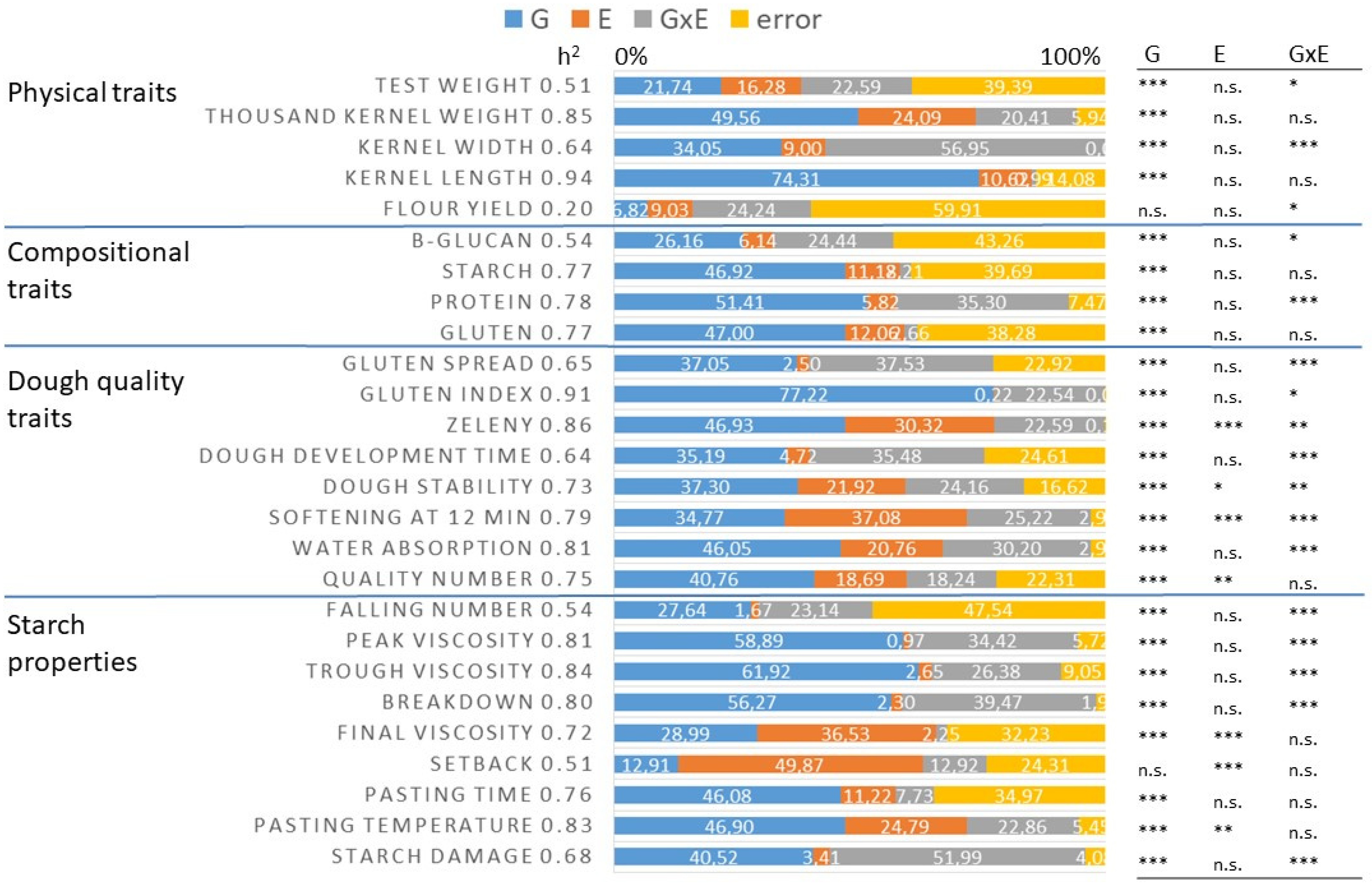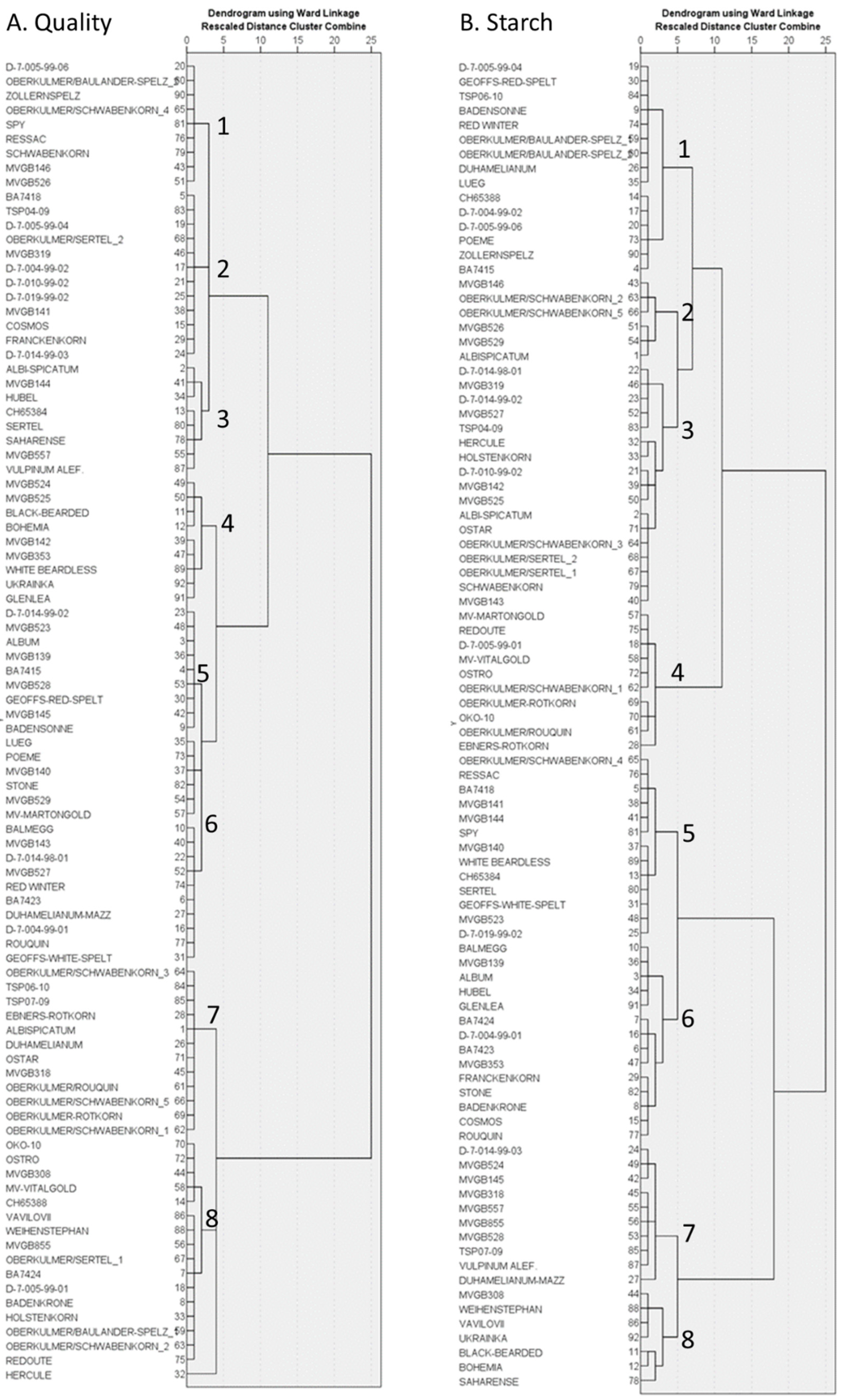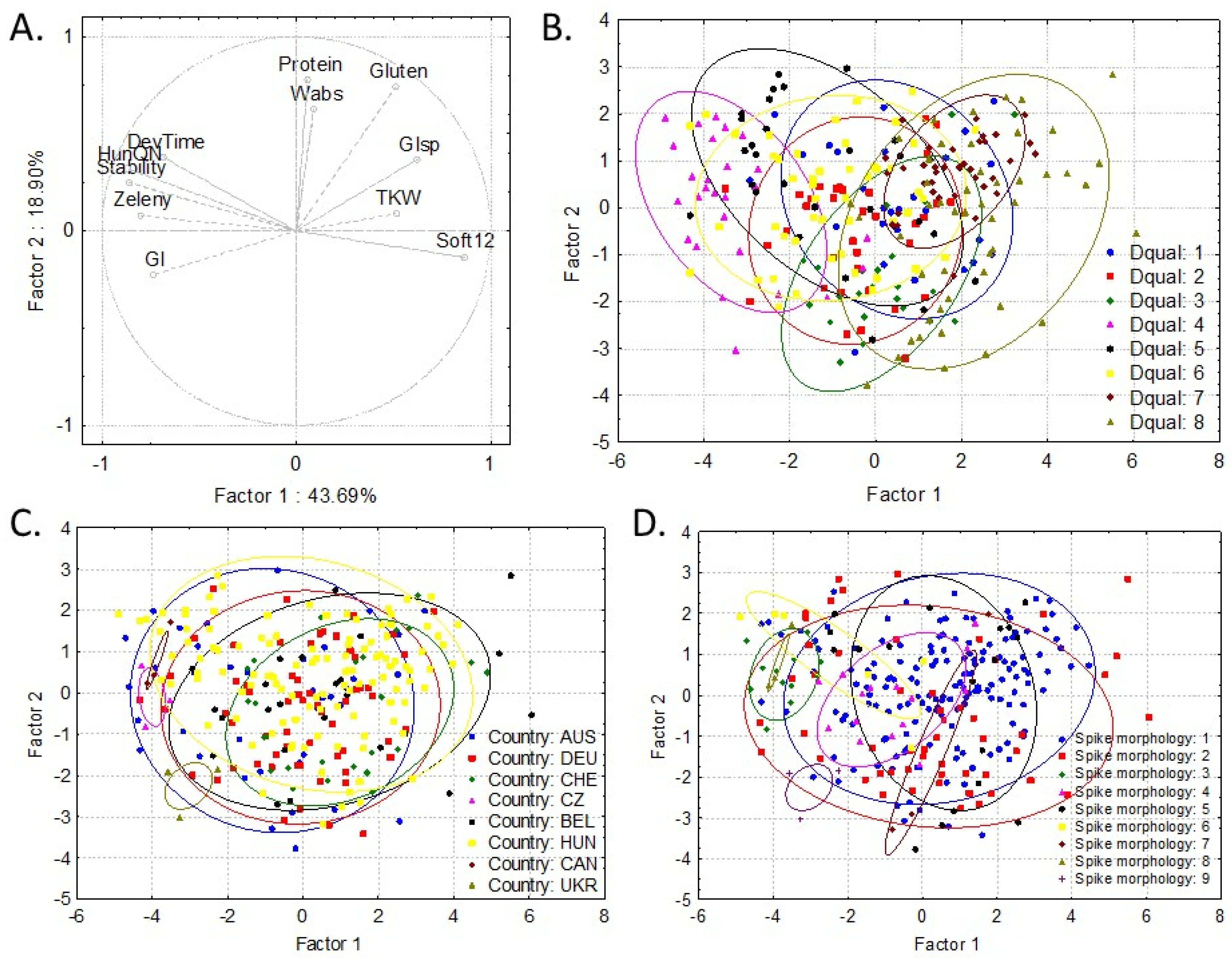Characterization of the Protein and Carbohydrate Related Quality Traits of a Large Set of Spelt Wheat Genotypes
Abstract
:1. Introduction
2. Materials and Methods
2.1. Plant Materials
2.2. Field Conditions
2.3. Analysis of the Physical Traits and Milling
2.4. Analysis of the Compositional Traits
2.5. Analysis of Dough Properties
2.6. Starch Properties
2.7. Statistical Analysis
3. Results
3.1. Diversity of the Physical, Compositional, and Breadmaking Quality
3.2. Variance and Heritability
3.3. Hierarchical Cluster Analysis
3.4. Characterization of Spelt Genotypes
4. Discussions
5. Conclusions
Supplementary Materials
Author Contributions
Funding
Data Availability Statement
Conflicts of Interest
References
- Sousa, T.; Ribeire, M.; Sabenca, C.; Igrejas, G. The 10,000-year success story of wheat. Foods 2021, 10, 2124. [Google Scholar] [CrossRef] [PubMed]
- Alvarez, J.B. Spanish spelt wheat: From an endangered genetic resource to a trendy crop. Plants 2021, 10, 2748. [Google Scholar] [CrossRef] [PubMed]
- Rai, B.; Takahashi, H.; Kato, K.; Sato, Y.; Nakamura, I. Single-copy nuclear PolA1 gene sheds light on the origin of S genome with relationships to B and G genomes of polyploid wheat species. Genet. Resour. Crop Evol. 2012, 59, 1713–1726. [Google Scholar] [CrossRef]
- Peng, J.H.; Sun, D.; Nevo, E. Domestication evolution, genetics and genomics in wheat. Mol. Breed. 2011, 28, 281–301. [Google Scholar] [CrossRef]
- Zohary, D.; Hopf, M.; Weiss, E. Domestication of Plants in the Old World: The Origin and Spread of Domesticated Plants in Southwest Asia, Europe, and the Mediterranean Basin; Oxford University Press on Demand: Oxford, UK, 2012. [Google Scholar]
- Sormacheva, I.; Golovninva, K.; Vavilova, V.; Kosuge, K.; Watanabe, N.; Blinov, A.; Goncharov, N.P. Q gene variability in wheat species with different spike morphology. Genet. Resour. Crop Evol. 2015, 62, 837–852. [Google Scholar] [CrossRef]
- Doebley, J.F.; Gaut, B.S.; Smith, B.D. The molecular genetics of crop domestication. Cell 2006, 127, 1309–1321. [Google Scholar] [CrossRef] [Green Version]
- Gill, B.S.; Li, W.; Sood, S.; Kuraparthy, V.; Friebe, B.R.; Simone, K.J.; Zhang, Z.; Faris, J.D. Genetics and genomics of wheat domestication-driven evolution. Isr. J. Plant Sci. 2007, 55, 223–229. [Google Scholar] [CrossRef]
- Gradmann, R. Der Dinkel und die Alemannen. In Württembergische Jahrbücher für Statistik und Landeskunde; Statistical Bureau of Wurttemberg: Stuttgart, Germany, 1901; pp. 103–158. [Google Scholar]
- Arzani, A. Emmer (Triticum turgidum spp. dicoccum) flour and breads. In Flour and Breads and Their Fortification in Health and Disease Prevention; Elsevier: Amsterdam, The Netherlands, 2011; pp. 69–78. [Google Scholar]
- Righetti, L.; Rubert, J.; Galaverna, G.; Folloni, S.; Ranieri, R.; Stranska-Zachariasova, M.; Hajslova, J.; Dall’Asta, C. Characterization and Discrimination of Ancient Grains: A Metabolomics Approach. Int. J. Mol. Sci. 2016, 17, 1217. [Google Scholar] [CrossRef] [Green Version]
- Frakolaki, G.; Giannou, V.; Topakas, E.; Tzia, C. Chemical characterization and breadmaking potential of spelt versus wheat flour. J. Cereal Sci. 2018, 79, 50–56. [Google Scholar] [CrossRef]
- Gomez-Becerra, H.F.; Erdem, H.; Yazici, A.; Tutus, Y.; Torun, B.; Ozturk, L.; Cakmak, I. Grain concentrations of protein and mineral nutrients in a large collection of spelt wheat grown under different environments. J. Cereal Sci. 2010, 52, 342–349. [Google Scholar] [CrossRef]
- Koenig, A.; Konitzer, K.; Wieser, H.; Koehler, P. Classification of spelt cultivars based on differences in storage protein compositions from wheat. Food Chem. 2015, 168, 176–182. [Google Scholar] [CrossRef]
- Boukid, F.; Folloni, S.; Sforza, S.; Vittadini, E.; Prandi, B. Current Trends in Ancient Grains-Based Foodstuffs: Insights into Nutritional Aspects and Technological Applications. Compr. Rev. Food Sci. Food Saf. 2018, 17, 123–136. [Google Scholar] [CrossRef] [PubMed] [Green Version]
- Escarnot, E.; Dornez, E.; Verspreet, J.; Agneessens, R.; Courtin, C.M. Quantification and visualization of dietary fibre components in spelt and wheat kernels. J. Cereal Sci. 2015, 62, 124–133. [Google Scholar] [CrossRef]
- Rodríguez-Quijano, M.; Vargas-Kostiuk, M.-E.; Ribeiro, M.; Callejo, M.J. Triticum aestivum ssp. vulgare and ssp. spelta cultivars. 1. Functional evaluation. Eur. Food Res. Technol. 2019, 245, 1561–1570. [Google Scholar] [CrossRef]
- Wilson, J.D.; Bechtel, D.B.; Wilson, G.W.T.; Seib, P.A. Bread quality of spelt wheat and its starch. Cereal Chem. 2008, 85, 629–638. [Google Scholar] [CrossRef] [Green Version]
- Geisslitz, S.; Longin, C.F.H.; Scherf, K.A.; Koehler, P. Comparative Study on Gluten Protein Composition of Ancient (Einkorn, Emmer and Spelt) and Modern Wheat Species (Durum and Common Wheat). Foods 2019, 8, 409. [Google Scholar] [CrossRef] [Green Version]
- Dhaka, V.; Khatkar, B.J. Effects of gliadin/glutenin and HMW-GS/LMW-GS ratio on dough rheological properties and breadmaking potential of wheat varieties. J. Food Qual. 2015, 38, 71–82. [Google Scholar] [CrossRef]
- Prandi, B.; Tedeschi, T.; Folloni, S.; Galaverna, G.; Sforza, S. Peptides from gluten digestion: A comparison between old and modern wheat varieties. Food Res. Int. 2017, 91, 92–102. [Google Scholar] [CrossRef]
- MSZ 6367/4-86; Edible, Fodder and Industrial Seeds and Husked Products. Determination of Test Weight, Thousand Kernel Weight and Classification Grade. Hungarian Standards Institution: Budapest, Hungary, 1986.
- International Association for Cereal Science and Technology ICC 167; Determination of Crude Protein in Grain and Grain Products for Food and Feed by the Dumas Combustion Principle. International Association for Cereal Science and Technology: Vienna, Austria, 1995.
- International Association for Cereal Science and Technology ICC 137/1; Mechanical Determination of the Wet Gluten Content of Wheat Flour (Glutomatic). International Association for Cereal Science and Technology: Vienna, Austria, 1995.
- International Association for Cereal Science and Technology ICC 202; Procedure for Near Infrared (NIR) Reflec-Tance Analysis of Ground Wheat and Milled Wheat Products. International Association for Cereal Science and Technology: Vienna, Austria, 1995.
- AACC International, Approved Methods 32–23.01; Beta-Glucan Content of Barley and Oats–Rapid Enzymatic Proce-dure. AACC International: St. Paul, MN, USA, 1995.
- International Association for Cereal Science and Technology ICC 115/1; Method for using Brabender Farinograph. International Association for Cereal Science and Technology: Vienna, Austria, 1995.
- International Association for Cereal Science and Technology ICC 155; Determination of Wet Gluten Quantity and Quality (Gluten Index ac. to Perten) of Whole Wheat Meal and Wheat Flour (Triticum Aestivum). International Association for Cereal Science and Technology: Vienna, Austria, 1995.
- International Association for Cereal Science and Technology ICC 116/1; Determination of the Sedimentation Value (According to Zeleny) as an Approximate Measure of Baking Quality. International Association for Cereal Science and Technology: Vienna, Austria, 1997.
- Tömösközi, S.; Nádosi, M.; Balázs, G.; Gergely, S.; Cavanagh, C.; Morgounov, A.; Salgó, A.; BÉKÉS, F. Revival of sedimentation value—Method development, quality prediction and molecular background. In Proceedings of the 10th International Gluten Workshop, INRA, Clermont-Ferrand, France, 7–9 September 2009; pp. 104–108. [Google Scholar]
- AACC International, Approved Methods 56-81B; Determination of Falling Number. AACC International: St. Paul, MN, USA, 1995.
- American Association of Cereal Chemists. General Pasting Method for Wheat or Rye Flour of Starch Using the Rapid Visco Analyser, 8th ed.; Approved Methods of the AACC, Method 76-21, Starch; American Association of Cereal Chemists: St. Paul, MN, USA, 1991. [Google Scholar]
- Batey, I.L.; Curtin, B.M.; Moore, S.A. Optimization of rapidvisco analyser test conditions for predicting Asian noodle quality. Cereal Chem. 1997, 74, 497–501. [Google Scholar] [CrossRef]
- International Association for Cereal Science and Technology ICC 172; Flour from Wheat (Triticum Aestivum)—Determination of Damaged Starch by an Amperometric Method Using the SDMatic, 2007. International Association for Cereal Science and Technology: Vienna, Austria, 1995.
- Virk, D.S.; Pandit, D.B.; Sufian, M.A.; Ahmed, F.; Siddique, M.A.B.; Samad, M.A.; Rahman, M.M.; Islam, M.M.; Ortiz-Ferrara, G.; Joshi, K.D.; et al. REML is an effective analysis for mixed modelling of unbalanced on-farm varietal trials. Exp. Agric. 2009, 45, 77–91. [Google Scholar] [CrossRef] [Green Version]
- Schmidt, P.; Hartung, J.; Bennewitz, J.; Piepho, H.-P. Heritability in Plant Breeding on a Genotype-Difference Basis. Genetics 2019, 212, 991–1008. [Google Scholar] [CrossRef] [PubMed]
- Skrabanja, V.; Kovac, B.; Golob, T.; Liljeberg Elmstahl, H.G.M.; Bjorck, I.M.E.; Kreft, I. Effect of spelt wheat flour and kernel on bread composition and nutritional characteristics. J. Agric. Food Chem. 2001, 49, 497–500. [Google Scholar] [CrossRef] [PubMed]
- Bodroža-Solarov, M.; Mastilovic, J.; Filipcev, B.; Simurina, O. Triticum aestivum spp. spelta: The potential for the organic wheat production. J. Process. Energy Agric. 2009, 13, 128–131. [Google Scholar]
- Ranhotra, G.S.; Gelroth, J.A.; Glaser, B.K.; Stallknecht, G.F. Nutritional profile of three spelt wheat cultivars grown at five different locations. Cereal Chem. 1996, 73, 533–535. [Google Scholar]
- Marconi, E.; Carcea, M.; Graziano, M.; Cubadda, R. Kernel properties and pasta-making quality of five European spelt wheat (Triticum spelta L.) cultivars. Cereal Chem. 1999, 76, 25–29. [Google Scholar] [CrossRef]
- Mikos, M.; Podolska, G. Bread-making quality of old common bread (Triticum aestivum ssp. vulgare L.) and spelt (Triticum aestivum ssp. spelta L.) wheat cultivars. J. Food Agric. Environ. 2012, 10, 221–224. [Google Scholar]
- Frakolaki, G.; Giannou, V.; Tzia, C. The properties and breadmaking potential of freshly baked and frozen bakery products during partial replacement of wheat flour with spelt flour. Food Sci. Technol. Int. 2020, 26, 485–492. [Google Scholar] [CrossRef]
- Callejo, M.J.; Vargas-Kostiuk, M.E.; Rodríguez-Quijano, M. Selection, training and validation process of a sensory panel for bread analysis: Influence of cultivar on the quality of breads made from common wheat and spelt wheat. J. Cereal Sci. 2015, 61, 55–62. [Google Scholar] [CrossRef] [Green Version]
- Longin, C.F.H.; Ziegler, J.; Schweiggert, R.; Koehler, P.; Carle, R.; Würschum, T. Comparative Study of Hulled (Einkorn, Emmer, and Spelt) and Naked Wheats (Durum and Bread Wheat): Agronomic Performance and Quality Traits. Crop Sci. 2016, 56, 302–311. [Google Scholar] [CrossRef]
- Castagna, R.; Borghi, B.; Di Fonzo, M.; Heun, N.; Salamini, F. Yield and related traits of einkorn (Triticum monococcum ssp. monococcum) in different environments. Eur. J. Agron. 1995, 4, 371–378. [Google Scholar] [CrossRef]
- Grausgruber, H.; Sailer, C.; Ghambashidze, G.; Bolyos, L.; Ruckenbauer, P. Genetic variation in agronomic and qualitative traits of ancient wheat. In Genetic Variation for Plant Breeding; Vollmann, J., Grausgruber, H., Ruckenbauer, P., Eds.; EUCARPIA & BOKU-Univ. of Natural Resources and Applied Sciences: Vienna, Austria, 2004; pp. 19–22. [Google Scholar]
- Mondini, L.; Grausgruber, H.; Pagnotta, M.A. Evaluation of European emmer wheat germplasm for agro-morphological, grain quality traits and molecular traits. Genet. Resour. Crop Evol. 2014, 61, 69–87. [Google Scholar] [CrossRef]
- Andruszczak, S. Spelt wheat grain yield and nutritional value response to sowing rate and nitrogen fertilization. J. Anim. Plant Sci. 2018, 28, 1476–1484. [Google Scholar]




| Descriptive Statistics | Mean | Standard Deviation | Minimum | Maximum | Range | ‘Glenlea’ | ‘Ukrainka’ |
|---|---|---|---|---|---|---|---|
| N = 270 | T. aestivum | ||||||
| Test weight (kg/100 L) | 70.51 | 4.44 | 58.90 | 81.90 | 23.00 | 79.57 | 75.60 |
| Thousand kernel weight (g) | 36.93 | 5.33 | 23.22 | 49.79 | 26.57 | 42.63 | 38.31 |
| Kernel width (mm) | 2.93 | 0.17 | 2.50 | 3.50 | 1.00 | 3.24 | 3.18 |
| Kernel length (mm) | 7.32 | 0.45 | 6.00 | 8.30 | 2.30 | 7.08 | 6.70 |
| Flour Yield (%) | 58.22 | 4.31 | 31.82 | 75.12 | 43.30 | 60.17 | 54.72 |
| β glucan content (mg/g) | 6.54 | 0.66 | 4.53 | 8.46 | 3.93 | 5.95 | 6.79 |
| Starch content (%) | 52.94 | 1.46 | 49.20 | 57.80 | 8.60 | 55.73 | 55.57 |
| Protein content (%) | 18.99 | 1.61 | 12.17 | 22.20 | 10.03 | 16.30 | 14.53 |
| Gluten content (%) | 44.71 | 6.01 | 29.30 | 59.80 | 30.50 | 35.97 | 28.90 |
| Gluten spread (mm/h) | 7.80 | 3.88 | 1.00 | 20.50 | 19.50 | 2.50 | 1.17 |
| Gluten Index | 59.28 | 19.58 | 0.73 | 98.89 | 98.15 | 97.32 | 99.70 |
| Zeleny sedimentation (mL) | 34.78 | 9.67 | 16.00 | 73.00 | 57.00 | 48.00 | 45.67 |
| Dough development time (min) | 4.75 | 4.61 | 0.30 | 20.00 | 19.70 | 19.87 | 1.94 |
| Dough stability (min) | 9.54 | 6.35 | 0.00 | 19.60 | 19.60 | 17.47 | 18.17 |
| Dough softening at 12 min (FU) | 76.06 | 49.61 | 0.00 | 306.00 | 306.00 | 45.00 | 30.33 |
| Water absorption (%) | 55.95 | 2.07 | 51.30 | 63.30 | 12.00 | 62.90 | 60.00 |
| Quality Number | 59.73 | 21.29 | 0.00 | 100.00 | 100.00 | 100.00 | 76.90 |
| Falling number (sec) | 383.28 | 62.14 | 103.00 | 613.00 | 510.00 | 416.00 | 428.00 |
| Peak Viscosity (cP) | 3706.24 | 207.59 | 3178.00 | 4213.00 | 1035.00 | 3817.00 | 3939.00 |
| Trough Viscosity (cP) | 1751.42 | 110.17 | 1426.00 | 2116.00 | 690.00 | 1783.67 | 2072.00 |
| Breakdown (cP) | 1954.82 | 163.30 | 1622.00 | 2377.00 | 755.00 | 2033.33 | 1867.00 |
| Final Viscosity (cP) | 3824.95 | 276.01 | 2981.00 | 4643.00 | 1662.00 | 3528.00 | 4157.00 |
| Setback (cP) | 2073.53 | 211.28 | 1520.00 | 2965.00 | 1445.00 | 1744.33 | 2085.00 |
| Pasting Time (min) | 9.08 | 0.10 | 8.73 | 9.33 | 0.60 | 8.96 | 8.91 |
| Pasting Temperature (°C) | 63.48 | 1.01 | 60.90 | 66.00 | 5.10 | 61.60 | 61.17 |
| Starch Damage (UCD) | 12.75 | 1.79 | 6.30 | 19.40 | 13.10 | 17.35 | 18.85 |
Publisher’s Note: MDPI stays neutral with regard to jurisdictional claims in published maps and institutional affiliations. |
© 2022 by the authors. Licensee MDPI, Basel, Switzerland. This article is an open access article distributed under the terms and conditions of the Creative Commons Attribution (CC BY) license (https://creativecommons.org/licenses/by/4.0/).
Share and Cite
Tóth, V.; Láng, L.; Vida, G.; Mikó, P.; Rakszegi, M. Characterization of the Protein and Carbohydrate Related Quality Traits of a Large Set of Spelt Wheat Genotypes. Foods 2022, 11, 2061. https://doi.org/10.3390/foods11142061
Tóth V, Láng L, Vida G, Mikó P, Rakszegi M. Characterization of the Protein and Carbohydrate Related Quality Traits of a Large Set of Spelt Wheat Genotypes. Foods. 2022; 11(14):2061. https://doi.org/10.3390/foods11142061
Chicago/Turabian StyleTóth, Viola, László Láng, Gyula Vida, Péter Mikó, and Marianna Rakszegi. 2022. "Characterization of the Protein and Carbohydrate Related Quality Traits of a Large Set of Spelt Wheat Genotypes" Foods 11, no. 14: 2061. https://doi.org/10.3390/foods11142061
APA StyleTóth, V., Láng, L., Vida, G., Mikó, P., & Rakszegi, M. (2022). Characterization of the Protein and Carbohydrate Related Quality Traits of a Large Set of Spelt Wheat Genotypes. Foods, 11(14), 2061. https://doi.org/10.3390/foods11142061






